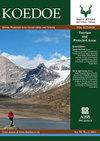南非喀拉哈里大羚羊国家公园38年来的动态变化
IF 1.1
4区 环境科学与生态学
Q3 BIODIVERSITY CONSERVATION
引用次数: 6
摘要
瓦切利亚(Vachellia erioloba)是卡拉哈里南部的一种重要树种。这项长达近40年的长期研究追踪了一个大型保护区不同景观(内部沙质沙丘和粘土Nossob河床)中的两个种群,并提供了在自然土壤湿度条件下和有限人为影响下该物种的宝贵数据。1978年,在喀拉哈里大羚羊国家公园(Dankbaar遗址)内部一片1公顷的荒地上,18棵树被永久标记。1979年对Nossob河床1公顷地块内的所有树木进行了调查(Grootkolk站点)。在这两个地点,为了调查生长速度和种群结构,随后在2016年之前不定期测量树高和茎周长。在Dankbaar的18棵被标记的树木中,有6棵死亡,3棵在火灾后大量枯死后出现了灌木林的再生。2016年平均高度增加60 mm/年,剩余未被砍伐树木的平均高度为6.8 m。茎粗年生长率在不同树种和不同年份之间差异很大,38年期间的平均值为2.5 mm/年。3个10年周期计算的增长率各不相同。利用目前研究得出的平均生长率和枯死树木的茎长,估计了树木死亡时的平均年龄。在Grootkolk遗址,相对于直径分类范围中点的质心位置表明,该种群正在逐渐成为一个成熟的到老年的种群,招募有限。这得到了大小类分布曲线的支持。然而,茎径大小类分布的坡度和截距之间没有差异。保护意义:本研究是在一个大型保护区进行的,即一个自然生态系统,不包括公园外存在的大多数人为威胁。该研究表明,在沙漠中,研究的人口是自我维持的,有招募的发生,大的个体可能会死于老年。虽然火灾造成一些人死亡,但没有与火灾有关的死亡报告。在Nossob河床,调查开始于一个主要是幼树的林分,在那个阶段的大小类分布已经显示出缺乏补充。这个摊位正在老化,可能会在这个地点消失;然而,在诺索河床的其他地方出现了新的幼林。因此,在目前可以忽略人为影响的条件下,公园内的一些紫叶弧菌种群数量在增加,而另一些种群数量在减少,但总体而言,该物种将继续存在。然而,全球气候变化对这一物种的影响尚不清楚。本文章由计算机程序翻译,如有差异,请以英文原文为准。
Vachellia erioloba dynamics over 38 years in the Kalahari Gemsbok National Park, South Africa
Vachellia erioloba is a keystone tree species in the southern Kalahari. This long-term study over nearly four decades tracks two populations in different landscapes (the interior sandy duneveld versus the clayey Nossob riverbed) of a large conservation area and offers valuable data on this species under natural soil moisture conditions and with limited anthropogenic influences. In 1978, 18 trees were permanently marked in a 1 ha plot in the interior duneveld of the Kalahari Gemsbok National Park (Dankbaar site). In the Nossob riverbed all trees in a 1 ha plot were surveyed in 1979 (Grootkolk site). At both sites, tree height and stem circumference were subsequently measured at irregular intervals until 2016 in order to investigate growth rates and population structure. Of the 18 marked trees at Dankbaar, six died and three showed coppice regrowth following substantial dieback after a fire. A mean height increase of 60 mm/year was recorded and the mean height of the remaining uncoppiced trees was 6.8 m in 2016. Stem diameter growth rate per year varied widely between trees and between years with a mean value of 2.5 mm/year over the 38-year period. Growth rate calculated for three 10-year intervals varied. Using the mean growth rate derived in the current study and stem size of the dead trees, the mean age of the trees when they died was estimated. At the Grootkolk site, the position of the centroid in relation to the midpoint of the diameter class range suggests that this population is gradually becoming a mature to old population with limited recruitment. This was supported by the size class distribution curves. However, no differences between slopes or intercepts of the stem diameter size class distributions were found.Conservation implications: This study was conducted in a large conservation area, that is, a natural ecosystem excluding most of the anthropogenic threats that are present outside of the park. The study illustrated that in the duneveld the population studied was self-sustaining, with recruitment occurring and large individuals presumably dying of old age. Although fire caused a few individuals to coppice, no fire-related deaths were reported. In the Nossob riverbed, surveys started in a stand of predominantly young trees and the size class distribution at that stage already showed a lack of recruitment. This stand is ageing and will likely disappear at this site; however, new young stands are appearing at other sites in the Nossob riverbed. Under the current conditions with negligible anthropogenic influences, it therefore appears that some V. erioloba populations in the park are increasing in size while others are decreasing, but that overall the species will persist. The impact of global climate change on this species is, however, unknown.
求助全文
通过发布文献求助,成功后即可免费获取论文全文。
去求助
来源期刊

Koedoe
BIODIVERSITY CONSERVATION-
CiteScore
3.30
自引率
0.00%
发文量
10
审稿时长
20 weeks
期刊介绍:
Koedoe, with the subtitle ''African Protected Area Conservation and Science'', promotes and contributes to the scientific (biological) and environmental (ecological and biodiversity) conservation practices of Africa by defining the key disciplines that will ensure the existence of a wide variety of plant and animal species in their natural environments (biological diversity) in Africa.
 求助内容:
求助内容: 应助结果提醒方式:
应助结果提醒方式:


